Always power down and unplug your devices completely before cleaning. Use anti-static cleaners specifically made for electronics and avoid harsh chemicals like ammonia or bleach. Apply cleaning solutions to a microfiber cloth first, never directly on devices. Keep moisture away from ports and openings, and discharge static electricity by touching grounded metal. Handle screens gently with appropriate cleaners and soft cloths. Guarantee good ventilation during cleaning, and follow manufacturer guidelines carefully. Let devices dry completely before powering up. Don't rush the cleaning process, and maintain regular cleaning schedules. These basic steps will help you protect your valuable electronics, but there's much more to mastering safe cleaning techniques.
Power Down Before You Start
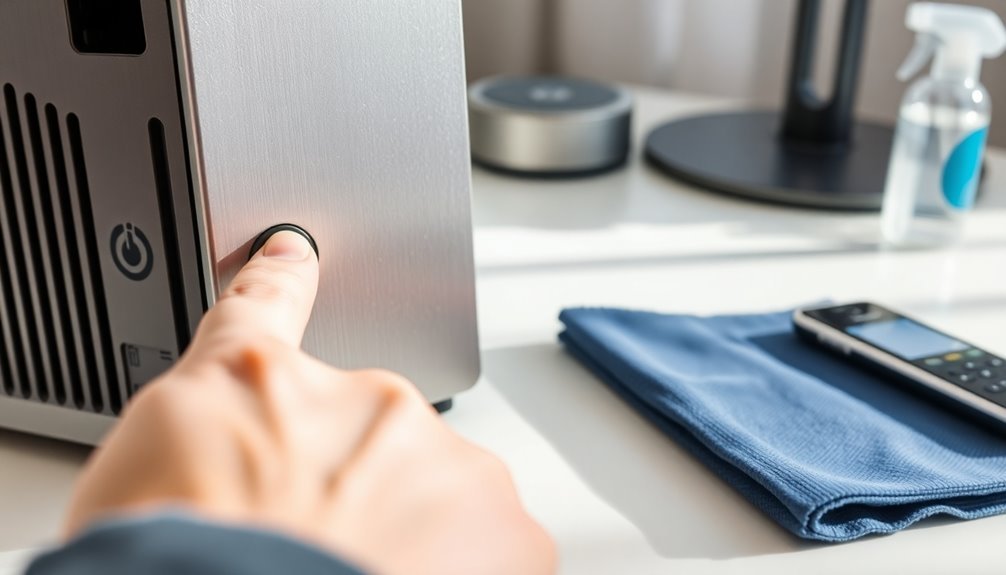
Three critical steps must be taken before cleaning any electronic device: power it down completely, unplug it from all power sources, and remove any batteries if possible. These steps aren't just recommendations – they're essential safety measures that protect both you and your devices from potential harm.
When you're preparing to clean your electronics, don't skip the power-down process or rush through it. Make sure your device isn't just in standby mode but completely shut down. Consult online manuals if you're unsure about your specific model's shutdown procedure.
You'll need to unplug all cables and power cords, including USB connections and charging cables. If your device has removable batteries, take them out to prevent any accidental power-ons during cleaning.
Before you start cleaning, let your device cool down completely. Hot components can be damaged during cleaning, and cooling time helps protect sensitive internal parts.
You'll also want to discharge any static electricity by touching a grounded metal surface. Don't forget to check your device's manual for specific cleaning instructions – manufacturers often provide important guidance for their products.
Choose Anti-Static Cleaning Solutions
Selecting the right cleaning solution for your electronics isn't just about removing dirt – it's about protecting your devices from static damage.
When you choose an anti-static cleaner, look for products specifically designed for electronic equipment that don't contain ammonia or harsh solvents. Products like Endust Multi-Surface Anti-Static Electronics Cleaner and 3M Electronic Equipment Cleaner are formulated to stay on surfaces without running. You can find these and other quality cleaning supplies at Office Depot stores, with over 960 retail locations nationwide.
You'll want to guarantee your chosen cleaner is compatible with various electronic surfaces and safe for plastics. The best anti-static cleaners will help reduce static charges and prevent dust build-up while safely cleaning your devices. They're typically non-flammable and free from oils and waxes that could damage your equipment.
When using these cleaners, don't spray directly onto your devices. Instead, apply the solution to a microfiber cloth first, making sure it's not too wet.
Keep moisture away from any device openings and allow equipment to air dry completely before powering it on.
Always check your device manufacturer's cleaning recommendations and follow the cleaner's instructions carefully. These precautions will help you maintain your electronics safely while preventing static-related damage.
Microfiber Cloths Are Essential
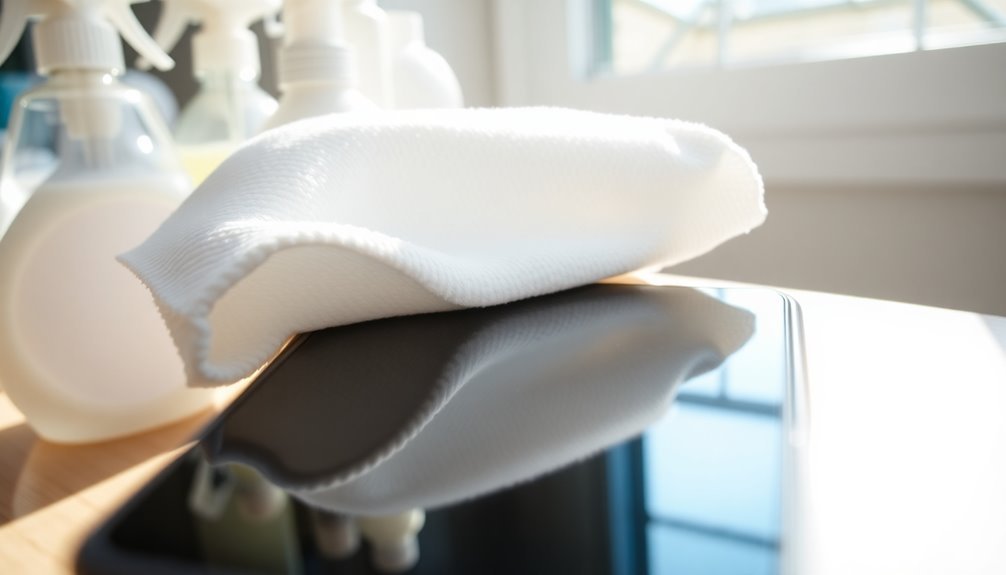
Cleaning your electronics properly starts with microfiber cloths – they're the essential tool in any device maintenance kit. These specialized cloths reduce your need for harsh chemicals while effectively capturing dust, bacteria, and other contaminants through their static electric charge.
Since microfiber is 1/100th the thickness of a human hair, it can reach into the tiniest crevices of your electronics for thorough cleaning.
They're incredibly absorbent, holding up to eight times their weight in liquid, which helps prevent excess moisture from damaging your devices.
When using microfiber cloths on your electronics, never spray cleaning solutions directly onto your devices. Instead, dampen the cloth with a 70% isopropyl alcohol solution for disinfecting. You'll want to use gentle pressure, especially on screens and sensitive components. Always power down your devices before cleaning them.
To maintain your microfiber cloths' effectiveness, wash them separately from other materials to prevent lint contamination. Use a gentle detergent without fabric softeners or fragrances, and wash them in cool water. Air-drying is best, but if you must use a dryer, choose the lowest heat setting.
Before washing, shake out any loose dirt to maintain the cloth's cleaning capacity. With proper care, your microfiber cloths will remain effective for cleaning everything from smartphone screens to printer surfaces.
Keep Moisture Away From Components
When cleaning electronics, you'll need to keep moisture away from sensitive components by never spraying cleaning solutions directly onto devices.
Instead, you should apply a minimal amount of cleaning solution to your cloth first, ensuring it's just slightly damp rather than wet.
You'll want to carefully control the dampness level of your cleaning cloth by wringing out any excess moisture before wiping surfaces to prevent any liquid from seeping into openings or ports. Even small amounts of moisture can cause performance degradation in electronic devices over time.
Never Spray Direct Contact
A critical rule in electronics cleaning is to never spray cleaning solutions directly onto devices. Direct spraying can lead to severe damage as liquids can seep into openings and create pathways for electrical shorts, potentially causing complete device failure.
When moisture infiltrates your electronics, it can corrode metal components and destroy sensitive internal parts. Working in a well-ventilated area will help surfaces dry faster and prevent harmful fume buildup.
Instead, you'll want to apply cleaning solutions to a microfiber cloth first. Make sure the cloth is just damp, not soaking wet, and gently wipe the surface of your device. Don't wipe excessively, as this could force moisture into openings.
Let the cleaned areas air dry completely before using your device.
You should always follow your device manufacturer's specific cleaning guidelines. They'll typically recommend appropriate cleaning products and methods for your particular device.
Before you begin cleaning, don't forget to disconnect your device from any power source to prevent electrical shock. You'll want to avoid using harmful substances like bleach, aerosols, or abrasive cleaners, as these can permanently damage your electronics.
Use Minimal Solution Always
Successfully maintaining electronic devices requires using the absolute minimum amount of cleaning solution necessary. When cleaning electronics, you'll want to guarantee your microfiber cloth is just slightly damp, never wet enough to drip. This careful approach prevents excess moisture from seeping into sensitive components, which can cause short circuits or corrosion. Following manufacturer cleaning guidelines is essential to ensure you're using appropriate methods for your specific device.
Before cleaning any electronic device, make sure it's unplugged and powered off. Apply your cleaning solution (preferably 70% or higher isopropyl alcohol) to the microfiber cloth first, never directly onto the device. You'll need to wring out the cloth thoroughly to remove any excess moisture that could potentially drip into openings or vents.
If you're dealing with a spill, don't panic, but act quickly. Gently blot the liquid rather than wiping it, which could spread the damage.
For dust removal, opt for compressed air in short bursts rather than liquid solutions.
If you're cleaning circuit boards or internal components, use specialized flux removers sparingly and allow complete drying time before reassembly.
When in doubt about cleaning methods or if you encounter serious spills, don't hesitate to seek professional help to avoid voiding your warranty.
Control Cloth Dampness Level
The proper dampness level of your cleaning cloth stands as the critical factor in safely maintaining electronic devices. When cleaning electronics, you'll need to verify your cloth is damp but never dripping wet.
The ideal cleaning solution consists of 70% isopropyl alcohol mixed with 30% water, but remember to wring out excess moisture before touching any electronic surface.
You'll want to achieve an even dampness across your microfiber cloth to prevent concentrated wet spots that could seep into your device's components. Never spray cleaning solutions directly onto your electronics or submerge them in liquid. Instead, apply the solution to your cloth first, guaranteeing it's just damp enough to clean effectively without risking moisture damage. For extra protection, wear disposable gloves while handling cleaning solutions and wiping down surfaces.
Before you begin cleaning, unplug your device and disconnect any external components. As you wipe, use gentle, directional strokes from top to bottom, taking special care around buttons, ports, and panel edges where moisture could enter.
If you notice your cloth becoming too wet during cleaning, switch to a drier section or get a fresh cloth. Always allow surfaces to air-dry completely before powering your device back on.
Protect Against Static Discharge
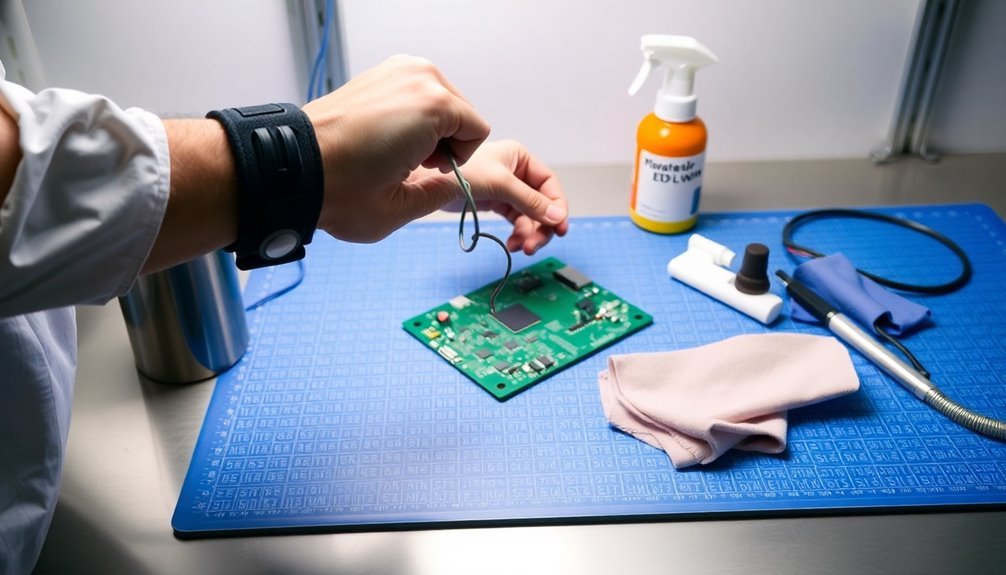
Static discharge poses a significant risk when cleaning electronics, making proper precautions essential for protecting sensitive components.
Before you start cleaning, make certain you're properly grounded by wearing an ESD wrist strap and heel straps connected to a grounding system.
You'll need to maintain the work environment at 30-50% humidity and 18-22°C temperature to minimize static buildup.
Always use ESD-safe cleaning tools and pre-saturated wipes specifically designed for electronics.
You'll want to disconnect power sources before cleaning electrical contacts and use specialized contact cleaners that won't damage sensitive components.
Install ESD protective mats and treat floors with anti-static compounds, removing any carpets or rugs from the area.
Keep your electronics away from blowing air and plastic materials that can generate static charges.
You'll need to use static dissipating cleaning tools, such as ESD-safe flux remover dispensing systems.
Remember to allow sufficient drying time after cleaning to prevent moisture-related issues.
When working in cleanroom settings, wear anti-static clothing and shoe covers that meet EN 1149-3 standards, and use ESD-safe furniture to maintain a static-free environment.
Clean Between Device Components
Cleaning between device components calls for precision and careful attention to prevent damage to sensitive parts. You'll need to use appropriate cleaning solutions designed specifically for electronics, avoiding harsh chemicals that could harm delicate components. Instead of applying cleaners directly to the device, dampen a microfiber cloth with an alcohol-based or specialized electronic cleaning solution.
When working between components, use gentle tools like soft-bristled brushes or microfiber cloths. Don't insert cleaning implements too deeply into openings, and maintain a safe distance when using compressed air to remove dust.
You'll want to be especially careful around ports and small spaces where moisture could become trapped.
For specialized cleaning needs, you might consider ultrasonic cleaning or vapor degreasing, but only if appropriate for your specific components. If you're dealing with flux residue, match your flux remover to the type of flux used, and guarantee you're regularly changing the solvent to avoid contamination.
Remember to let all surfaces completely air dry before powering on your device, and never spray liquids directly onto components or into device openings.
Handle Screens With Care
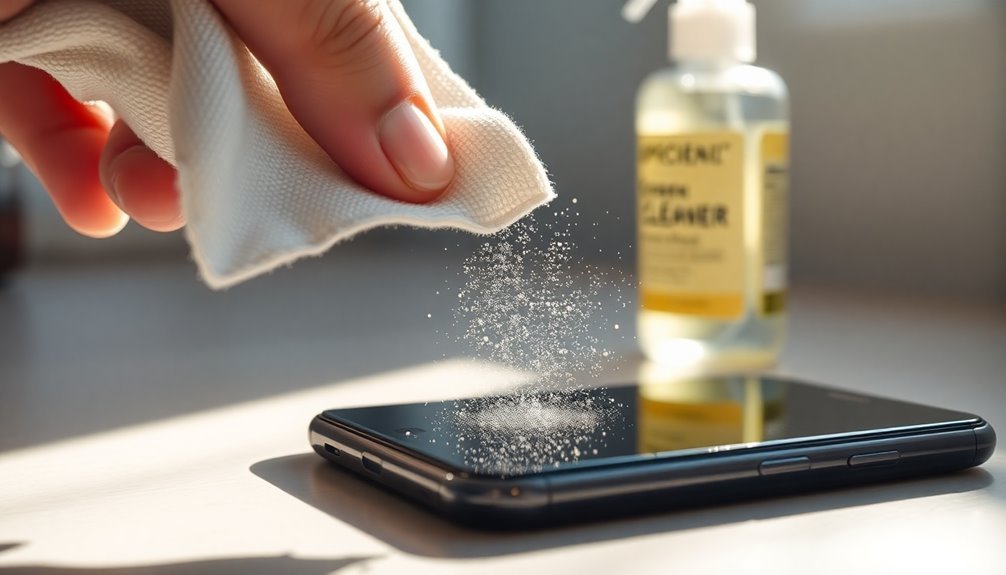
Maintaining screen integrity requires proper care and attention to prevent permanent damage to your device's display. Before you begin cleaning, power off your device and disconnect it from any power source.
You'll need a soft, lint-free microfiber cloth as your primary cleaning tool.
Never spray cleaning solutions directly onto screens. Instead, lightly dampen your microfiber cloth with distilled water or use specialized screen-cleaning wipes.
Clean the screen using gentle circular motions, paying extra attention to stubborn spots and edges where dust often accumulates. If you're dealing with dust, use compressed air from at least 6 inches away, keeping the can upright.
Don't use paper towels, tissues, or household cleaners, as they can scratch or damage your screen's protective coating. Avoid harsh chemicals unless specifically recommended by your device's manufacturer.
After cleaning, verify the screen is completely dry before powering on your device.
Make screen cleaning a regular part of your device maintenance routine. Work in well-ventilated areas and check for streaks after cleaning.
Don't forget to clean your peripherals too, as they can contribute to screen dust buildup.
Ventilation Requires Special Attention
Proper ventilation plays a crucial role in electronics cleaning and maintenance to prevent hazardous fume buildup and protect sensitive components. You'll need to guarantee your workspace has adequate ventilation systems that include high-efficiency filtration to capture harmful particles and vapors.
Install local exhaust ventilation at your soldering stations and cleaning areas to capture fumes directly at their source. If you're using solvents or applying conformal coatings, you'll want enclosed systems with dedicated exhaust ventilation to contain and remove volatile organic compounds (VOCs).
For cleanroom environments, implement HEPA or ULPA filters to maintain strict air purity standards.
You should monitor your ventilation system's performance regularly. Install instruments to track differential pressures, airflow velocities, and temperature.
Don't forget to check for leaks or breaks in the system, and clean ductwork periodically to prevent dust accumulation. Make sure your air circulation moves from clean to less clean areas to prevent cross-contamination.
Always maintain positive pressure in your cleanroom areas to keep contaminants out, and position fans and air handlers externally to avoid introducing additional contamination sources into your workspace.
Follow Device-Specific Guidelines
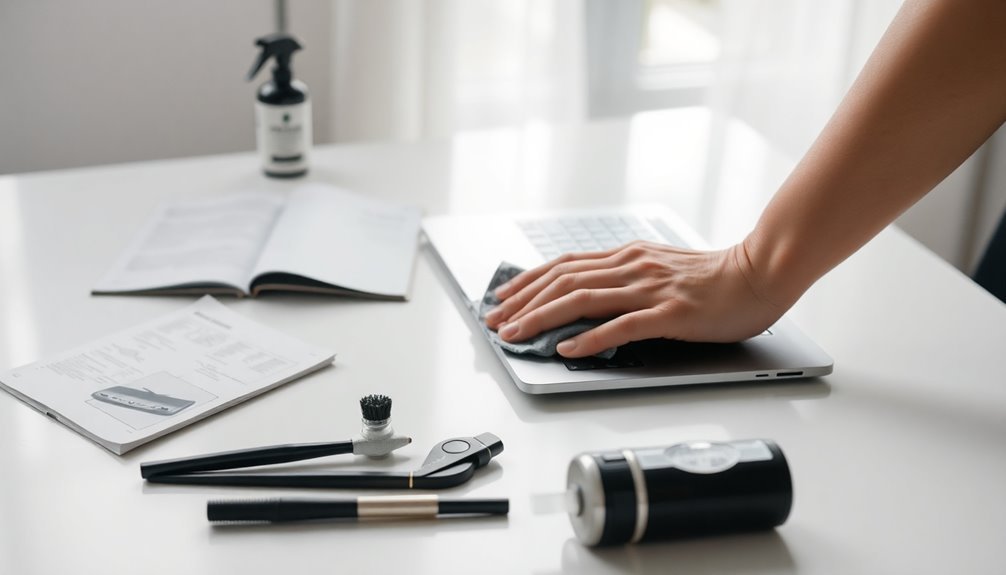
When working with electronics, each device requires its own specific cleaning approach to prevent damage and maintain functionality. Before you start cleaning, power down your devices, disconnect external components, and remove batteries from wireless accessories.
Always use soft, lint-free cloths to protect sensitive surfaces.
You'll want to use 70% alcohol pads or wipes for most electronic equipment, but don't spray cleaners directly onto devices. Instead, apply the disinfectant to a microfiber cloth first.
For screens and touchscreens, use gentle cleaning solutions specifically designed for displays. When cleaning keyboards, apply minimal cleaner to your cloth and wipe carefully to prevent liquid from seeping underneath the keys.
Before attempting any internal cleaning, unplug your devices and discharge static electricity by touching a metal surface. You'll need to follow manufacturer-specific guidelines to maintain your warranty coverage.
For printers and copiers, use a slightly damp microfiber cloth with 70% isopropyl alcohol. Don't forget to observe the contact time listed on disinfectant labels for effective sanitization.
Regular maintenance cleaning will prevent buildup and extend your device's lifespan, but avoid harsh chemicals and excessive moisture that could cause damage.
Allow Complete Drying Time
Natural air drying your electronics after cleaning provides the safest method to prevent moisture damage while avoiding heat-related risks to sensitive components.
You'll need to carefully inspect hidden areas under components where moisture can become trapped, using compressed air or lint-free wipes to reach these spots.
Plan to wait at least 24 hours after cleaning sensitive electronics with distilled water or isopropyl alcohol, ensuring all surfaces are completely dry before powering on your device.
Natural Air Dry Benefits
Complete air drying stands as a critical step in electronics cleaning that you can't afford to skip. When you properly air dry your electronic devices, you'll prevent moisture-related damage that could lead to costly repairs or replacements. Natural air drying guarantees all components are thoroughly dried, protecting against electrical shorts and corrosion.
| Benefit | Impact | Why It Matters |
|---|---|---|
| Complete Drying | Prevents moisture retention | Eliminates risk of electrical shorts |
| Corrosion Prevention | Protects internal parts | Extends device lifespan |
| Short Circuit Protection | Safeguards electrical components | Prevents system failures |
| Component Safety | Preserves sensitive parts | Maintains device functionality |
| Enhanced Longevity | Promotes device durability | Saves money on repairs |
You'll want to guarantee there's no visible moisture before powering on your devices. Don't rush this process by using heat or forced air, as these methods can damage sensitive components. Instead, let your electronics dry naturally at room temperature. Using microfiber cloths can help absorb excess moisture without leaving behind residue. Remember, while the drying process might seem time-consuming, it's essential for maintaining your device's performance and preventing potential damage from trapped moisture.
Check Hidden Moisture Areas
To protect electronics from moisture and humidity, several strategies and tools can be employed:
Drying Water-Damaged Electronics
When electronics are exposed to water, it is crucial to dry them carefully to prevent further damage. Here are some steps:
- Dry the device with a towel to remove as much water as possible. Be gentle and thorough, avoiding damage to wiring or circuitry inside.
- Do not use a hairdryer, heat gun, or place the device in direct sunlight, as these methods can cause additional damage.
- Use a drying agent such as rice, silica gel packets, or cat litter to absorb any remaining moisture in the device. Place the device in an airtight container with the drying agent to help dehumidify it.
Using Desiccant Packs
Desiccant packs are highly effective for protecting electronics from humidity:
- These packs contain adsorbent materials, most commonly silica gel, which can absorb up to 40% of their weight in water. This helps keep the environment around the electronics dry.
- Place desiccant packs inside packaging containers, storage boxes, or even within the device's casing if possible. This absorbs moisture from the air and prevents it from affecting the electronics.
- Desiccant packs can become saturated over time and may need to be replaced or regenerated by drying them in a low-temperature oven.
Maintaining a Low-Humidity Environment
Keeping the environment around electronics within a safe humidity range is essential:
- Use a dehumidifier to keep the relative humidity (RH) between 30-50%. This is particularly effective for rooms where electronics are stored.
- Use a hygrometer to regularly check the humidity levels around your devices to ensure they remain within safe limits.
- Keep electronic devices away from areas prone to moisture such as kitchens, bathrooms, and basements. Choose well-ventilated, climate-controlled spaces for storage.
Regular Maintenance and Inspection
Regular maintenance can help prevent moisture buildup:
- Use a microfiber cloth to clean surfaces regularly and prevent moisture from settling in crevices.
- Inspect vents and openings on devices, as these can trap condensation. Also, check behind screens and displays, and keyboard and mouse compartments for hidden dampness.
- Regularly power up devices that have been unused for long periods to dissipate moisture through the heat inside the device.
Additional Protective Measures
Other measures to protect electronics include:
- Installing ventilation fans or cooling fans near electronic equipment to improve air circulation and reduce moisture buildup.
- Ensuring all vents or openings on the electronic device are unobstructed to allow heat and moisture to escape.
- Using moisture-proof mats or waterproof bases to avoid direct contact with wet floors or desks, especially in humid areas.
- Applying moisture-resistant conformal coatings or anti-corrosion sprays for high-value or sensitive equipment.
Optimal Drying Time Guidelines
Understanding proper drying time can make the difference between saving and destroying your electronics after cleaning. You'll need to allow 4-8 hours for thorough drying and deodorizing of desktop computers, though this time can safely extend overnight if needed. When dealing with soot-contaminated devices or strong odors, plan for longer drying periods.
| Device Condition | Recommended Drying Time |
|---|---|
| Standard Clean | 4-8 hours minimum |
| Heavy Odors | 8-24 hours |
| Soot Damage | 12-24 hours |
| Light Cleaning | 2-4 hours |
Never rush the drying process – moisture trapped inside your device can cause serious damage. When using 70% isopropyl alcohol for cleaning, you'll need to account for its water content in drying time. Keep your device in a well-ventilated area during drying, and don't attempt to speed up the process with external heat sources. For daily cleaning, use a slightly damp microfiber cloth and wipe in one direction, particularly on screens. Always guarantee complete dryness before powering on your device, and remember that prevention through regular cleaning will reduce the need for deep cleaning sessions.
Frequently Asked Questions
How Often Should I Clean My Electronic Devices?
You'll need to clean your devices based on their usage: mobile devices weekly, shared electronics daily, computers monthly, and DVD players quarterly. Regular cleaning prevents dust buildup and extends their lifespan.
Can I Use Sanitizing Wipes Meant for Hands on Electronics?
No, you shouldn't use hand sanitizing wipes on electronics. They contain harsh chemicals that can damage your devices. Instead, use electronics-specific wipes or a microfiber cloth with 70% isopropyl alcohol for safe cleaning.
Is It Safe to Clean Electronics in Humid Environments?
You shouldn't clean electronics in humid environments. High humidity can cause condensation and moisture damage. Instead, work in a climate-controlled area with low humidity, and use dehumidifiers if needed for safety.
Should I Remove Protective Cases Before Cleaning My Devices?
Yes, you should always remove protective cases before cleaning your devices. It'll help prevent trapped moisture, allow better access to all surfaces, and guarantee you can thoroughly clean both the device and case separately.
What Temperature Should Cleaning Solutions Be When Cleaning Electronics?
For most electronics, you'll want to use cleaning solutions between 20-45°C. If you're using ultrasonic cleaning, aim for 55-60°C. Don't exceed 70°C to protect sensitive components and guarantee safe operation.
In Summary
Remember, you'll get the best results by following all these cleaning tips consistently. Since you're dealing with sensitive electronic equipment, there's no room for shortcuts. When you maintain your devices properly, you're protecting your investment and extending their lifespan. Don't skip any steps in the cleaning process – each one plays a vital role in keeping your electronics running smoothly and safely.

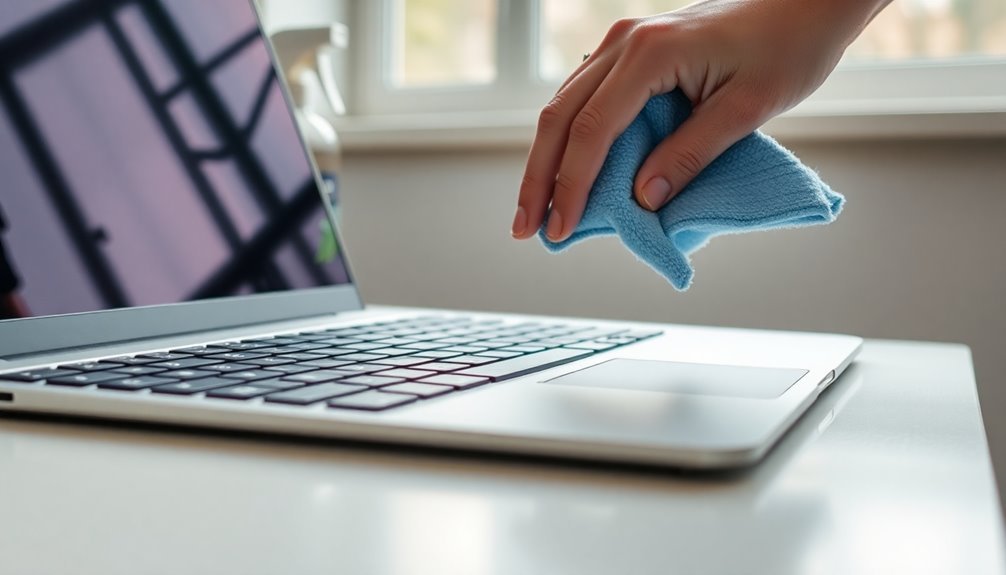



Leave a Reply